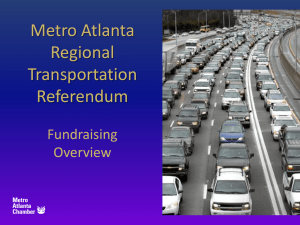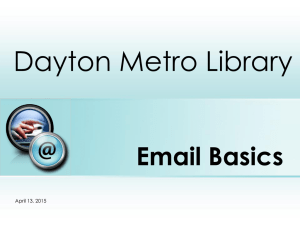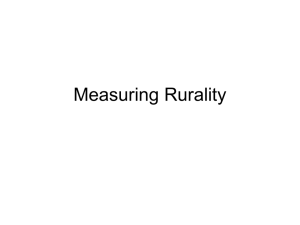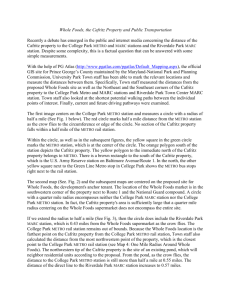Strategy to Urban Gridlock
advertisement
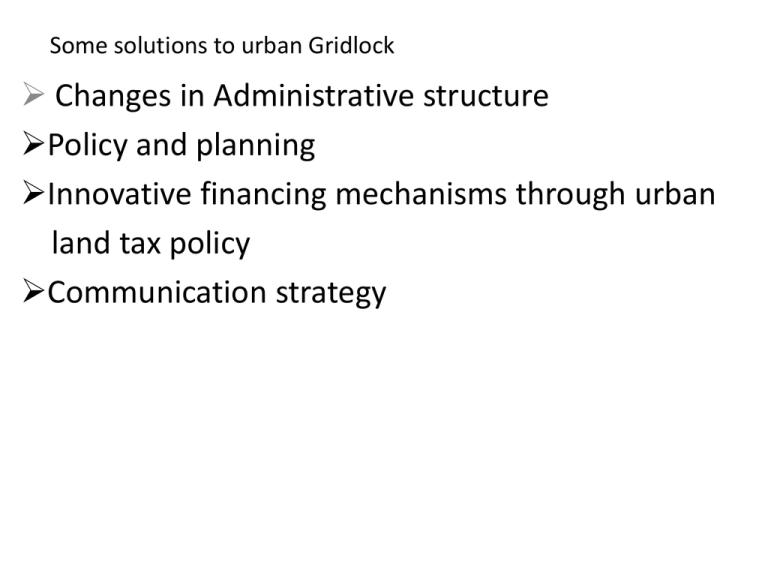
Some solutions to urban Gridlock Changes in Administrative structure Policy and planning Innovative financing mechanisms through urban land tax policy Communication strategy Administrative Strategy First fix the agency responsible to develop high quality infrastructure for transport corridors. At present there are too many agencies and none assuming overall responsibility. What is need is an executive who has the authority to convert strategy into practical actions to ensure efficient utilization of resources. State Government should do more than create an Urban Land Transport Authority. It is headed by a Junior officer who has no executive powers. This needs to be fixed. A senior rank officer with members from civil society, trade and industry and elected representatives will make a difference. Its should be the Executive Body with independent budget allocation to develop transport corridors within the core city and suburban areas planned for future development by unbundling these corridors from local government. Capacitybuilding Problems of urban transport being recent to India substantial investment is required for capacity building for all the stakeholders including members of the civil society–and hence calls for strengthen capabilities. Optimize existing infrastructure Road widening to enhance capacity is not an easy option –expensive and disturbs social & environment fabric of the city. Compensation offered is below market rates and hence can get locked in litigation Efficient management of existing transport infrastructure would be the solution; This involves better road space management, signal free corridors, junction improvements, pedestrian infrastructure, shifting traffic from private to public transport to meet additional capacity through mass transit system. with mass public transit like the Metro in place, parking, setback & FAR norms needs to be revised. Planning & Management of urban land use FAR is generally based on three development criteria (1) Intensely developed (2) moderately developed & (3) sparsely developed. This is coupled with road width. Intense developed area being within the core city center where the demand for space is high has less the FAR, While sparsely developed areas where the demand is low, the FAR is high. Increased space will accommodate more people for work entertainment or housing and with mass transport will dissuade people from using private vehicles. However, the cost of maintaining or creation of new infrastructure will also burden the city managers. Developers should defrayed this cost through appropriate levies. Integrate land use and transport planning Cities being diverse land use and transport planning must internalize city specific features for a sustainable transport system and not just copy & paste. Future extensions of the city to be planned & land acquired for creating transport infrastructure before development takes place: this important for:Acquisition is cheaper. Enables creation of transport network with pedestrian, bicycle and tree path clearly defined Enables for hub-spoke arrangements to connect city centre through feeder service More importantly it broadly shapes the city’s development in a transparent manner and allows land market to operate more effectively to support land-use pattern Planning & Management of urban land use Some cities like Bangalore have increased the FAR for properties falling within 150 meters from the station boundaries from the existing 2.75 to 4 FAR. In the CBD area due to parking & set back restrictions it is difficult to achieve even 2.75 FAR Along with the changes to the building byelaws, government can devise policy to facilitate consolidate different neighboring properties along the mass transit corridors to enable joint development. This can be achieved by small interventions by the state: 1.Create single window to enable the process of consolidation of properties. 2.Exempt stamp duty for consolidation, and restrict stamp duty only to the extent of additional space created. 3.Government will earn revenue by way of stamp duty for additional space created. Financing options Transport Infrastructure projects like metro requires long term loan with low interest rates. Along with Center and State government equity participation, senior term debt is required. Multilateral agency funding takes time. Cities must do financing engineering to pool resources into the Urban Infrastructure Fund through various tax and user fee handles, like betterment levy on new layouts developed in peri-urban areas. A cess on redevelopment for all properties in the core city based on additional area built Additional stamp duty for the additional FAR achieved for properties along metro corridor Additional stamp duty for additional FAR achieved from properties permitted for consolidation. Infrastructure cess on all motor vehicles to defray the maintenance cost of existing infrastructure. Bangalore Metro Rail Project Some of the policies implement through specific notification for metro: Resolving Land Acquisition: Costed Rs.1800 Crs ($400 Million) Land acquisition compensation paid at market rates and for loss of building at replacement cost. Valuation fixed by independent committee serviced by professional bodies and in accordance with International Valuation Standards. In affect compensation paid was about 1.5 times the existing market rates. Besides cash compensation for shifting allowance, rental income loss, business premise reestablishment allowance and a business loss allowance. Rehabilitation houses for 211 slums families was constructed each measuring 750 Squares and at a cost of Rs.9 lakhs ($20,000) before civil work commenced. Constructed with the involvement of slum dwellers in the design and construction. BBC has produced human interest story a documenting their journey from slum to their present living condition. Slum rehabilitation Slum rehabilitation Bangalore Metro Rail Project Finance engineering : Project cost Rs.11,906 Crs. ($2.6 Billion) Whole owned by GoI and GoK with equal equity of 15% of the project cost and with subordinate debt of 10 % and 15% respectively. Balance through senior term debt. Major contributor is JICA (Development Assistance loan) 64 Billion Yen with a tenure of 20 + 10 years at fixed 1.3% on outstanding Yen. Sovereign loan currency risk with Government of India Balance from ADB, AFD (at commercial borrowing rates) and K EXIM Bank (ECB route) with sub-sovereign guarantee, and repayment to all senior term debt under a waterfall mechanism of through the operation of a Trust Account. Foreign loans means currency risk & hedging is not cheap. To avoid hedging costs we are in the process of finalizing a tripartite arrangement whereby Kexim Bank lends to State Bank of India and SBI lends a term loan in INR at low rate as they have secured EUR at L+1.80-2%with 14 Bangalore Metro Rail Project Multilateral loan was easy to come by as : Land required for the project was acquired. Acquisition well documentation Environmental & social impacts addressed. Public consultation held. Environment impact study prepared and hosted in website. 90 % of the procurement was tied up through ICB bidding process. Utilities were all shifted and work was already underway with some sections registering 60% progress. BMRCL in close coordination with State government was able to devise an acceptable sub-sovereign guarantee. In short the project itself was structured around the normal due diligence practices adopted by multilateral agencies. Bangalore Metro Rail Project Other innovative sources Defrayed the construction cost of 2 station in private property through a PPP project. The PPP partner built station at his cost for the concession of nonacquisition of land and to develop property and connect with the Metro and under arrangement to share a percentage rental/advertisement income. Discussion with IT& BT companies to deposit their surplus funds with Metro on short term deposits rolled over for 10-15 years. The spin off benefit to them would be that the 2nd Phase of Metro will commence to connect their corridor. Short term funds will be backed by adequate bank guarantee. Innovative source of fund BDA is partnering with BMRCL in property development under a PPP model. BDA to pay BMRCL upfront certain sum at fixed interest rates, so that BMRCL can add additional lines. BDA would earn a higher share from PPP partner and BMRCL a lower share. BDA is income is exempted from Income Tax. While interest payment of BMRCL is entitled for 100% deduction from IT. BDA would contribute a % share of the revenue realized from to Urban Infrastructure Fund. BMRCL is also attempting long term tax free infrastructure bonds for phase II of the project. Thank you




